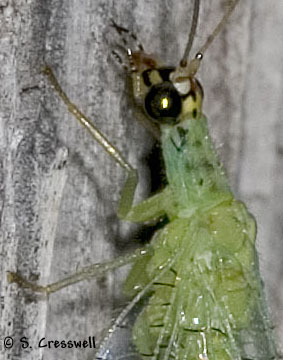Adaptation
The Chrysopa oculata is medium sized
(15-22 mm). It has chewing mouthparts, two golden eyes and a
black banding on the head. The body is usually elongate and
green in color. The antennae are long and slender. The Chrysopa
oculata have many-veined, lacelike, transparent wings that are
held roof like over the back when not in use. Adults are
generally terrestrial but they spend large amounts of time in
the air flying (Dunn 1996). Dormancy in
Chrysopa oculata is controlled by responses to photoperiod and
temperature. Differences in both the critical photoperiod for
diapause induction and the duration of diapause are related to
the latitudinal origin of the population. The incidence
of photoperiodically induced diapause also varies
geographically; at 24°C the southern-most population is more
variable for diapause induction than the northern populations (Nechols
et al.
1987).
